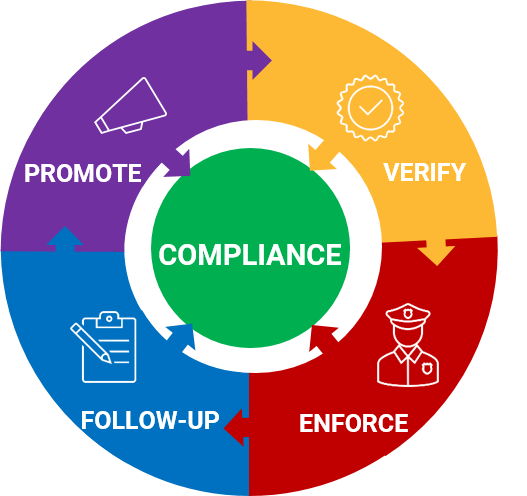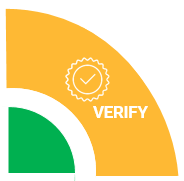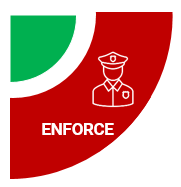Compliance and Enforcement Policy
Table of contents
1. Context
The Canadian Transportation Agency (Agency) is an independent regulator and quasi-judicial tribunal that regulates over 1,500 service providers in the air, rail, marine and interprovincial bus sectors. Using a variety of tools the Agency supports and verifies the compliance of regulated parties with the applicable acts, regulations, orders, and authorizations. It serves the public interest by resolving non-compliance through the application of a graduated approach, using informal and formal enforcement measures.
This Policy describes at a high level how the Agency organizes itself and delivers critical compliance and enforcement activities to best serve the public interest. Further, all Agency employees carry out their compliance monitoring and enforcement functions in a manner consistent with the Agency's Code of Values and Ethics.
2. Scope and Objective
The Agency has primary responsibility for administering the Canada Transportation Act (Act) and its associated regulations, and it shares responsibility for a number of other acts and regulations that involve the national transportation system (see Annex 1 for a list of acts and regulations).
The Agency has three core mandates:
- To help ensure that the national transportation system runs efficiently and smoothly in the interests of all Canadians: those who work and invest in it; the producers, shippers, travellers and businesses who rely on it; and the communities where it operates;
- To protect the human right of persons with disabilities to an accessible transportation network; and
- To provide consumer protection for air passengers.
This Policy applies to all programs within the Agency that have a compliance monitoring and enforcement function. The objective is to foster and ensure compliance by regulated entities with their legal obligations.
3. Guiding Principles
When undertaking compliance monitoring and enforcement activities within its mandate, the Agency is guided by the following principles:Note 1
Enforcement that is results-based – In securing compliance, the Agency adopts measures that are most likely to best serve the public interest, in light of the context and the specific circumstances of each case. This means that enforcement decisions account for a number of factors beyond findings of non-compliance.
Decision makingNote 2 that is data-driven and risk-informed– The Agency’s work is informed by data. The allocation of limited compliance and enforcement resources is optimized by developing, using and updating risk profiles of entities and performing data analysis to identify where potential non-compliance may be present or will occur in the future.
Processes that are fair, objective and consistent – Rules and processes for inspections, investigations and enforcement are clear, effectively communicated and applied in a consistent and impartial manner, noting that consistency is a feature of the manner of the compliance and enforcement process and not necessarily the result.
Enforcement that is proactive and responsive – While compliance and enforcement activities are subject to annual risk-based planning and strategies, the Agency also endeavours to promptly respond to emerging situations as they unfold, as well as to follow up on issues brought to the Agency’s attention.
Transparency – Consistent with statutory provisions and best practices, the Agency undertakes to publish on its website the results of its formal enforcement actions at the time of the issuance of a Notice of Violation.
4. Roles and Responsibilities
The Agency has Designated Enforcement Officers (DEOs), Compliance Analysts/Officers and Data Analysts at headquarters, as well as in regions across the country, delivering its compliance assurance mandate. Their work is informed and supported by staff in other parts of the organization with subject matter expertise in the air, rail, marine and interprovincial bus modes of transportation and in accessible transportation.
Designated Enforcement Officers
DEOs conduct compliance and enforcement activities. They have statutory powers of entry and inspection in carrying out their functions of verifying compliance with the Act, regulations and the Agency’s orders. These powers also allow DEOs to conduct administrative investigations that may result in the issuance of a Notice of Violation where they reasonably believe that a regulated entity has committed a violation.
Pursuant to the Act, the discretion to take and select enforcement measures rests with DEOs. However, and where deemed appropriate, the use of such discretion will be informed by this Policy and management oversight. Moreover, the use of enforcement discretion will always be informed by public interest objectives and this Policy’s Guiding Principles.
Compliance Officers, Compliance Analysts and Data Analysts
Compliance Analysts and Officers develop and implement compliance assurance strategies and monitoring tools that are used as part of regulated parties’ compliance reviews. They also monitor compliance with some regulatory provisions. Data Analysts undertake compliance pattern and trend analysis and use risk profiles to inform compliance and enforcement activities undertaken by DEOs.
5. Compliance Monitoring and Enforcement Continuum
Public interest objectives are best served when regulated entities undertake and comply voluntarily with applicable standards and legal obligations. To that end, the Agency undertakes an incremental range of compliance assurance activities, depending on the context and the circumstances of each situation. To encourage or compel compliance and to deter potential future non-compliance, each activity can be deployed independently or in succession.
This range of compliance assurance activities is the Agency Compliance Continuum. Compliance is encouraged through a variety of outreach, education and promotion activities. The Agency confirms compliance by monitoring and verifying. Enforcement measures compel compliance. Following-up on compliance verification and enforcement actions confirms that the measures taken have had the desired outcome and that compliance is being maintained.
Figure 1 – Agency Compliance Continuum

6. Compliance and Enforcement Tools and Responses
The Agency employs a number of different tools and activities within the Compliance Continuum to foster compliance and address instances of non-compliance.
 Promoting Compliance
Promoting Compliance
The Agency provides regulated entities with guidelines and other information to assist them in understanding their legal obligations. The Agency undertakes targeted outreach activities involving individual regulated entities, or groups of entities, in relation to specific statutory provisions to help entities fully understand their obligations and the consequences of non-compliance.
Compliance promotion may take the form of education and awareness campaigns, industry guidelines, interpretation bulletins and self-assessment questionnaires. Education can also be done in the context of compliance verification activities, such as inspections and targeted verifications.
 Verifying Compliance
Verifying Compliance
DEOs proactively monitor and assess compliance of regulated entities with legal obligations. They do so through the following activities:
- Follow-up and monitoring of regulated entities’ websites for compliance
- Virtual inspections of regulated entities to verify compliance
- Targeted verifications
- On-site carrier and facility inspection
- Targeted administrative investigations
Like other compliance verification activities, the nature and frequency of on-site inspections are informed by the regulated entity's risk profile and are generally conducted at the regulated entity's place of business, but may also take place at transportation facilities such as at airports, railway and marine terminals. These inspections can be either planned or unplanned, announced or unannounced.
Further, targeted administrative investigations can be carried out when a DEO reasonably believes that a contravention has occurred and that further evidence must be obtained to support an enforcement measure. Parties that become subjects of administrative investigations will be notified in writing at the outset. Consistent with principles of procedural fairness, parties under investigation will be provided with opportunities to make representations to a DEO, explain their conduct and provide evidence to support their position.
 Enforcing Compliance
Enforcing Compliance
In accordance with the Guiding Principles, the discretion to exercise enforcement authority is guided by results and informed by risk. In considering what is both the least intrusive and most effective enforcement instrument to employ, DEOs consider these factors:
- Characteristics of the alleged non-compliance – Context, harm, the seriousness of the conduct, the degree of negligence (for example, accidental vs negligent vs intentional);
- Characteristics of the alleged violator – Compliance history, cooperation offered to DEOs, measures taken to prevent or mitigate the impacts of the violation, whether the entity self-reported the violation;
- Others – Reliability of the evidence obtained, the prudent and optimal use of limited investigative resources, the need for general deterrence, the effectiveness of the measure.
The purpose of this analysis is to select the enforcement instrument that will be the most effective in causing the entity to return to or achieve compliance and prevent recurrence, while taking into account the graduated approach principle.
When a DEO believes that a regulated entity has committed a violation of the Act or regulations, or when a regulated entity has not complied with an Agency Order, and following a systematic consideration of the factors above, the DEO may select from the following enforcement actions:
- Cautionary Notices
- Notices of Violation with an Administrative Monetary Penalty (AMP)
- Prosecution.
For accessibility-related violations, the DEO may also decide to issue Notices of Violation with Warning.
A graduated approach, using informal to formal tools, is typically taken to address situations of potential non-compliance in selecting the most adequate enforcement measure. However, specific circumstances may call for a DEO to apply formal measures immediately, even in instances of first contraventions. This also applies to Notices of Violations with an AMP, where the circumstance may lead a DEO to levy a higher penalty than that provided by policy.
When a regulated entity is subject to a Notice of Violation with an AMP related to accessibility or requirements under the Air Passenger Protection Regulations, the regulated entity may request to enter into a Compliance Agreement with the Agency .
More information on each response is found in Annex 2.
 Follow-up Activities
Follow-up Activities
Following up on compliance verification and enforcement actions is a key feature of the Agency’s compliance and enforcement continuum. It ensures that actions and measures taken have had a desired outcome of achieving and maintaining compliance or witnessing a change in behaviour towards a compliance.
Such activities may include:
- Ensuring that terms and conditions of compliance agreements are adhered to (for accessibility and Air Passenger Protection Regulations violations)
- Ensuring that monetary penalties are paid
- Monitoring regulated entities response to Cautionary Notices
- Subjecting entities liable for violations to enhanced inspection and verification schedule
- Following-up on complaints that cannot proceed through the Agency's adjudication process
DEOs can also follow-up on Agency orders where such include terms and conditions to ensure timely compliance. Failure to comply with an Agency order is a violation that can be proceeded by way of a Notice of Violation.
Annex 1
Canadian Transportation Agency Legislation and Regulations:
- Canada Transportation Act
- Accessible Canada Act
- Accessible Transportation for Persons with Disabilities Regulations (note: provisions came into effect in June 25, 2020, and June 25, 2022)
- Accessible Transportation Planning and Reporting Regulations
- Personnel Training for the Assistance of Persons with Disabilities Regulations
- Air Passenger Protection Regulations
- Air Transportation Regulations
- Railway Third Party Liability Insurance Coverage Regulations
- Railway Interswitching Regulations
Annex 2
Cautionary Notice
A DEO may issue a Cautionary Notice to a regulated entity to convey the DEO's opinion that certain acts or omissions by the entity may contravene the Act or regulations. The Cautionary Notice has no legal force and does not constitute finding of liability but forms part of the compliance record and where repeat non-compliance occur, the enforcement response may escalate to AMPs. The DEO may exercise his or her discretion to use the Cautionary Notice when:
- the level of harm or severity of impact from the alleged non-compliance on affected passengers, market or industry is not high;
- the alleged non-compliance was inadvertent; or
- the regulated entity has not been issued a Notice of Violation for non-compliance with the provision(s) in question in the previous four years.
The notice advises the entity in writing that the Agency may take more formal enforcement action if the non-compliance is not resolved. The Cautionary Notice states the statutory or regulatory provision in respect of which there is an alleged violation and includes the facts that constitute the basis for the alleged non-compliance. It also contains corrective measures to be taken by the regulated entity to return and remain in compliance and the required timeframe.
DEOs follow-up with regulated entities to verify compliance with the provision(s) that are the subject of the notice. As an informal tool, Cautionary Notices are not subject to any review mechanism and are not published on the Agency's website.
Notice of Violation with an Administrative Monetary Penalty
Where a regulated entity contravenes a provision, requirement or condition that has been designated as one for which an AMP is available, the entity could be liable as an individual to an AMP not exceeding $5,000 and as a corporation up to $25,000. Certain other violations may render the entity liable for greater penalties (for example, a violation of insurance requirements for federally regulated railway companies of up to $100,000 or a violation in respect of failure to identify or remove mobility barriers for persons with disabilities of up to $250,000). The purpose of an AMP is to compel compliance, not to punish.
The Notice of Violation is issued by a DEO. It sets out the amount of the AMP, informs the entity of the date, location and substance of the non-compliance, and references the specific provision contravened. It provides a factual narrative and provides information on how the entity may either pay the amount of the assessed AMP or request a review of the facts or the amount of the penalty.
The Agency has assigned a severity rating to the violation of most designated provisions ranging from Level A (considered to be strictly administrative) to Level D, the most serious (Annex 2 contains examples). Each subsequent violation of the same provision within a four-year period by the same entity results in progressively higher penalty amounts, up to the maximum amount specified for each provision. Additionally, a violation that is committed or continues for more than one day can be considered a separate violation for each day the violation is committed or continues. In establishing the exact amount of the AMP, the DEO considers both aggravating and mitigating factors, including:
- Compliance history of the regulated entity
- Level of harm or severity of impact on affected passengers, market or industry;
- Effort on the part of the regulated entity to comply with or avoid the obligation;
- Level of effort on the part of the regulated entity to mitigate or reverse the violation’s effects;
- Extent of corrective action taken by the regulated entity to reach compliance and prevent future non-compliance; and
- Level of cooperation by the regulated entity during the administrative investigation.
More information on the AMP severity levels, baseline penalties and calculations can be found on the CTA website. This approach to calculating penalties only constitutes a guiding principle. Ultimately, DEOs can levy a penalty that is lower or higher, depending on the circumstances of an event of non-compliance, including the nature of the violation, its extent and the impact on the person(s) the provision is intended to protect.
Notices of Violations with AMP can be reviewed before the Transportation Appeal Tribunal of Canada (TATC). More information on the TATC review process can be found here as well as on the TATC website. A summary of all the Notices of Violations are published here.
Prosecution
Provisions in the Act and regulations may also in rare circumstances be prosecuted as offences. The laying of charges may be resorted to in circumstances that are particularly egregious, such as circumstances where there is wilful obstructive behaviour by the entity, or the provision of false or misleading information to a DEO or other offences that are committed with a criminal intent. AMPs are typically insufficient to prevent recurrence of these offences. As a matter of policy, the Agency will seek charge approval from the Public Prosecution Service of Canada prior to laying any charges for offences under the Act.
Notice of Violation with Warning (for Accessibility-Related Violations Only)
A DEO who believes that a regulated entity has committed a violation of an obligation intended to identify or remove barriers to the mobility of persons with disabilities may issue a Notice of Violation that contains a Warning but does not contain an AMP. This is distinct from a Cautionary Notice in that it does have legal effect and is subject to review if the entity files a written request for a review of the alleged violation with the Agency. More information related to this review process can be found here.
Compliance Agreement (for violations related to accessibility or requirements under the Air Passenger Protection Regulations)
A regulated entity that is served with a Notice of Violation with AMP may, instead of paying the full penalty or challenging the Notice of Violation before TATC, seek to enter into a Compliance Agreement with the Agency. A Compliance Agreement is a formal and enforceable agreement by which the regulated entity undertakes to come into compliance by meeting terms that the Agency considers appropriate. If the Agency is satisfied that the entity has complied with the terms, a Notice of Compliance is to be provided to the person and no further proceedings shall be taken against the person in respect of the contravention and, depending on the terms of the agreement, the AMP may be reduced in whole or in part and the entity’s security deposit would be returned to them. If, however, the Agency is of the opinion that the party failed to comply with any of the terms in the specified timeline, it shall serve a Notice of Default on the person informing them to pay twice the AMP amount or that the security, if any, given under the compliance agreement is forfeited to His Majesty in right of Canada.
Summaries of Compliance Agreements are published here.
- Date modified:

 Listen to text
Listen to text MP3
MP3